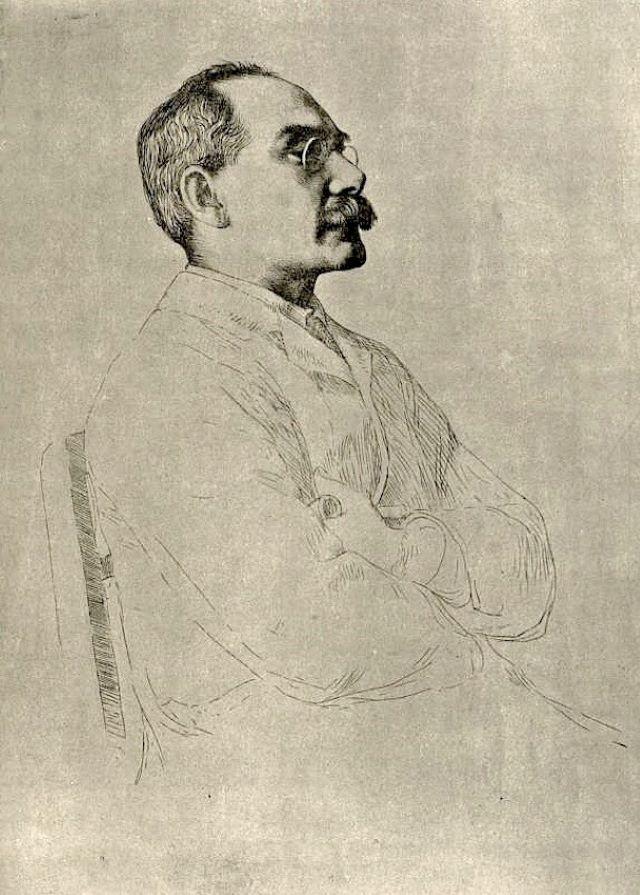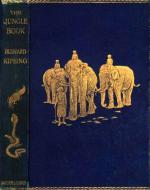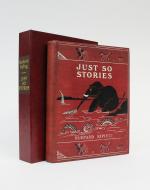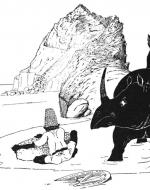Created by Kira Molnar on Mon, 03/01/2021 - 23:56
Description:
An anonymous reviewer of Just So Stories notes in a 1903 issue of The Atlantic : "It was only a century ago, as everybody remembers, that literary sucklings were nurtured on the Bible, Pilgrim's Progress, Paradise Lost, and Fox's Book of Martyrs" (The Atlantic). Didactic texts like these were given to children to instruct them and show them right from wrong. Such harsh and sometimes brutal texts are very different from the entertaining and amusing books and stories that emerged in the later nineteenth century that we read to children today. Rudyard Kipling's The Jungle Book (1894) and Just So Stories (1902) amuse children in a way that was not possible in the didactic cautionary tales written in the 17th, 18th, and 19th centuries that reigned over all else in children's literature. As the Atlantic reviewer goes on to say, Kipling's Just So Stories "does for very little children much what the Jungle Books did for older ones." Both illustrated children's books create a fun way of describing the world around us through a jungle adventure for older children and tales of how things came to be for young readers. That being said, it is important to note that Kipling's works are not without a moral. (“Just So Stories, by Rudyard Kipling.” The Atlantic, Atlantic Media Company, 1 May 1903, www.theatlantic.com/magazine/archive/1903/05/just-so-stories-by-rudyard-...).
Born December 30th, 1865 in Bombay, India, Rudyard Kipling is a reknowned English writer and storyteller. He wrote countless poems, short stories, and children's books, many of which are set in India. Two of his most well-known children's books are The Jungle Book (1894) and the Just So Stories (1902). Kipling's father, John Lockwood Kipling, was an artist himself, and he illustrated many of his son's books, including The Jungle Book.
The image posted here is an etching made by artist William Strang in 1898. As noted in the Victorian Web, "This is Strang's second etching of Rudyard Kipling: he had produced one in the previous year as well (Hind 330). Later, in 1900, he would make thirty aquatints and etchings to illustrate Kipling's short stories, which Macmillan published in 1901 in bound portfolios." (https://victorianweb.org/painting/strang/graphics/11.html).
John Lockwood Kipling, Cover of the First Edition The Jungle Book (1894), by Rudyard Kipling, Wikipedia.
Rudyard Kipling's father, John Lockwood Kipling, illustrated The Jungle Book, including the cover of this first edition. The Jungle Book revolves around a young boy named Mowgli, who grew up in the jungle in India and was raised by a pack of wolves. Mowgli learns his survival skills from his many animal friends and goes through countless life-threatening adventures. The Jungle Book works to entertain children in a way that makes reading fun and exciting. You get to read as Mowgli is kidnapped by the reckless and dangerous monkeys and how he narrowly escapes with his life after being saved by his friends. He finally faces off with the unrelenting Shere Khan, who despises all human and wants Mowgli dead. The Jungle Book is a story that transports you into a world of fun and adventure and is a far cry from the earlier stricter didactic texts.
John Lockwood Kipling, "The Tiger's Roar Filled the Cave With Thunder," for "Mowgli's Brothers," in The Jungle Book (1894), By Rudyard Kipling, Wikipedia.
This powerful illustration by John Lockwood Kipling is featured in Rudyard Kipling's The Jungle Book in Chapter One, "Mowgli's Brothers." Little Mowgli is visible here, sitting in the corner of the wolves' den together with the other wolf cubs. The two adult wolves are also visible as they ferociously defend this young human boy from the dangerous tiger Shere Khan, who desires Mowgli's death. Shere Khan has his head in the cave as he, too, growls and roars back at the wolves.
Although it is not depicted in this particular image, there is an important connection to be made about how Mowgli defeats Shere Khan in the end of the book and how the death of this tiger compares and contrasts to the way in which the didactic texts deal with death. In Mary Martha Sherwood's The History of the Fairchild Family, there is a chapter titled "The Sad Story Of A Disobedient Child" in which Augusta Noble, a young neighboring child of the Fairchild family, is burned alive by a candle. This exact same thing happens to Harriet in German didactic author Heinrich Hoffman's Struwwelpeter. In "The Dreadful Story About Harriet And The Matches," Harriet, too, is burned alive by lighting a match and catching her dress on fire. Both of these didactic authors use these deaths to scare children into being "good". The two girls in these stories have done "wrong" and as punishment they both die horrible deaths. Rudyard Kipling uses death of one who has sinned or done wrong in a very different way compared to the earlier didactic writers. Although all three of the stories follow the same ending, with the "bad" or "wicked" character dying, Shere Khan's death isn't as much of a warning to children to be good (or else...) as it is more the result of Mowgli's courage and bravery to fight back and defeat this villian who has been hunting him all his life.
Rudyard Kipling, Cover of the First Edition of Just So Stories (1902), by Rudyard Kipling.
Kipling's Just So Stories is a collection of tales that recount how things came to be. Many of the stories revolve around animals, such as: "How The Rhinoceros Got His Skin," "How The Camel Got His Hump," and "The Beginning Of The Armidillos." Although many of Kipling's books were illustrated by his father, the Just So Stories were actually illustrated by Rudyard Kipling himself. The cover illustration shown here is from one of the chapters in the book titled "The Elephant's Child." It depicts the crocodile pulling and stretching the Elephant's Child's nose until it becomes the long trunk we know and see in elephants today. The Bi-Coloured-Python-Rock-Snake is also visible in the image as it swims to the Elephant's Child's rescue and helps pull the elephant out of the crocodiles sharp, strong jaws.
Rudyard Kipling, "How The Rhinoceros Got His Skin," in Just So Stories (1902), by Rudyard Kipling, Wikipedia.
The illustration here is from the chapter "How The Rhinoceros Got His Skin" in Just So Stories. Depicted in this image is a rhinoceros with its original smooth and unwrinkled skin. (Originally, the species had very tight and smooth skin that they were able to unbutton and take off voluntarily.) On the shore of the Red Sea, on an uninhabited island, the rhinoceros watches as this human is finishing his very large cake (two feet across and three feet tall). After the rhinoceros storms in and eats the human's cake (rhinos were never well mannered and did whatever they pleased), the human decides to take his own action against this inconsiderate thief. He waits until the rhinoceros goes swimming on a very hot day. While the rhinocerous is swimming, the human steals the rhino's skin -- which has been laying next to the water -- and fills it with stale cake crumbs. After fully distributing the cake crumbs all throughout the skin, the human waits until the rhinoceros comes to put his skin back on. When the rhinoceros finally does so, he is terribly itchy all over and -- with no avail -- tries to rub and scrub all the crumbs away. From that day forward, all rhinos are bad tempered and have large wrinkly folds in their skin (The temper comes from always having itchy skin which they could not relieve). And so Rudyard Kipling sprinkles morals into his stories for young children; for had that first rhinoceros not been so greedy and rude and eaten all of the human's cake without permission, then rhinos today would not be wrinkled as they are today.






